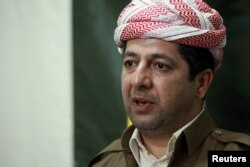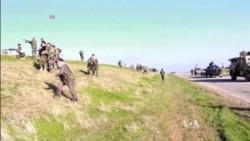Kurdish forces in northern Iraq on Friday said they have broken the Islamic State's siege of Mount Sinjar, claiming their biggest victory yet against the militant group and building on the news that three IS leaders have been killed.
Iraqi Kurdish peshmerga fighters fired rounds of ammunition at retreating IS militants after driving them out of a corner of northern Iraq, near the Syrian border. Scores of IS fighters are believed to have been killed in two days of battle that began Wednesday, Kurdish officials said.
Officials said roughly 8,000 Kurdish peshmerga troops, aided by U.S.-led coalition airstrikes, on Thursday recaptured a large amount of territory and lifted the lengthy siege of Mount Sinjar. Hundreds of refugees — mostly members of the Yazidi, a minority religious sect — had been trapped there since August.
Efforts to open a corridor offering escape to the Yazidi were ongoing late Friday, with peshmerga fighters moving to clear areas south of the mountain.
"Our hope is that all those people will eventually be able to go back to their own homes and villages and towns," said Masrour Barzani, the regional security council chief and son of Kurdish leader Massoud Barzani. "... Now a corridor has been opened to evacuate those people."
Watch related video report by VOA's Jeff Seldin:
In August, tens of thousands of Yazidis had been stranded there without adequate food or shelter after fleeing the Islamic extremists, prompting fears of a mass killing there at IS hands. U.S. airstrikes and airdrops eventually freed thousands, but in recent weeks many Yazidis and other Iraqis again were trapped on the mountain.
A Kurdish statement said the peshmerga recaptured eight villages in their offensive. Kurdish forces said that they drove hundreds of militants out of the town of Zumar and its surroundings, with some retreating to Syria.
U.S.-led coalition airstrikes provided key help, one Kurdish peshmerga commander told Iraqi TV. He said the militants were pushed out by peshmerga fighters and coalition warplanes from a radius of 100 kilometers, or 62 miles, between Sinjar Mountain and the Iraqi border town of Zumar.
U.S. Lieutenant General James Terry, who is leading U.S. forces in the coalition against the Islamic State, indicated more than 50 airstrikes have been carried out in the past few days to assist the peshmerga.
Strikes by the U.S. and its coalition partners continued Friday, with four attacks on IS fighters in Syria and 11 in Iraq. "All aircraft returned to base safely," the Pentagon reported, noting the attacks damaged or destroyed assorted buildings, vehicles and tactical units.
3 IS leaders killed
On Thursday, U.S. Defense Department officials said airstrikes in Iraq have killed three top IS leaders. They were identified as Haji Mutazz, a deputy to Islamic State leader Abu Bakr al-Baghdadi; Abd al-Basit, the Islamic State military emir in Iraq; and Radwin Talib, a mid-level official serving as the emir of Mosul.
They were killed during airstrikes conducted between mid-November and early December, officials said.
Pentagon officials said Thursday such gains were hampering the militant group's ability to command and control areas it occupies in Iraq and Syria.
U.S. military officials Thursday credited the more than 1,300 airstrikes and a stronger Iraqi security force for having a "significant effect" on the IS militants' ability to operate in Iraq.
Terry said the strikes are taking a toll, though he warned it might take at least three more years to rout the militants.
"Daesh [the Islamic State] has been halted and is transitioning to the defense and is attempting to hold what they currently have," Terry said, referring to the Islamic State by its Arabic acronym.
He called the militant group’s strategic shift a clear departure from what it was doing before airstrikes began in August. It's "having a hard time in terms of communicating right now, in terms of resupply," he said.
That's hurting IS' ability to push out propaganda, recruit new fighters and even spread fear, Terry added. "You can go to social media and see some of the stuff that’s coming out of places like Mosul in relationship to the inability of the self-declared caliphate to govern."
Another authoritative source, Jane's Intelligence Review, reported last week there has been no significant change in the tempo of Islamic State operations since airstrikes began. According to Jane's, IS advances in Samarra indicate the group's offensive capabilities and control of Sunni areas have not been degraded.
Spirits rise in Sinjar, though concerns persist
In Sinjar, there is optimism. "With the help of our friends and the alliance, we will evict them from all Iraq," a peshmerga colonel said of the IS militants.
There's also lingering concern. Some Yazidi leaders on Mount Sinjar feared sporadic fighting and bad weather would delay their departure for at least a week.
Coalition officials also are cautious, and the challenge remains of bringing more of Iraq’s Sunni tribes back into the fight on the side of a government that once alienated them.
There are also questions about the Islamic State’s hold in Syria, where U.S. plans to find and train a moderate opposition force have yet to get underway.
Hilal Khashan, who teaches political science at the American University of Beirut, told VOA that the Kurdish peshmerga offensive in the Sinjar region was probably part of a broader Kurdish offensive, including northern Syria, designed to split Islamic State forces in two.
The attack on Sinjar coincided with attacks by Kurds in the northeast Syrian town of Hassakah, Khashan said, “and it occurs to me that the two offensives are coordinated. The coalition is not really interested in defeating ISIL right now in Syria, but by cutting them off [at the border], they make the task of defeating them in Iraq much easier."
VOA's Jeff Seldin contributed to this report, which also contains some information from AFP.














